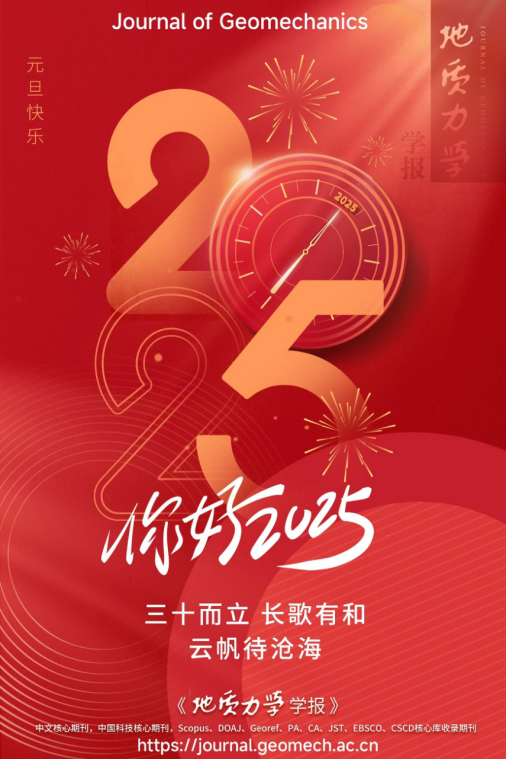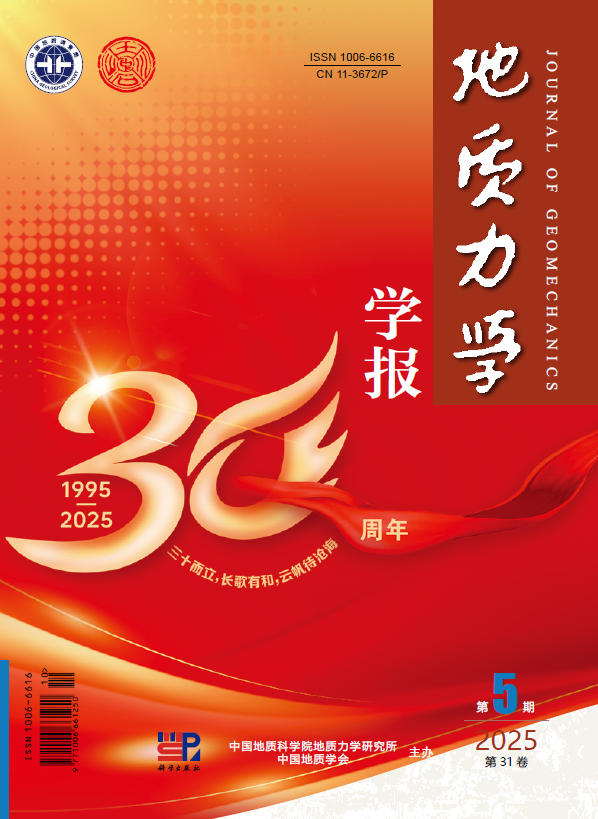The main directions of the Journal of Geomechanics are the theoretical research of geomechanics and its application in solving major resource and environmental problems such as mineralization, reservoir formation, geological hazards, and the evolution of the Earth. The key topics in 2025 are as follows:
Tectonic system and structural geology
l New Cathaysia tectonics and the basin-and-range system in eastern mainland China
l Tethys evolution and resource-environment implications
l Precambrian tectonic evolution of the North China Craton
l Formation and reconstruction of the South China continent
l Evolution of orogenic belts and structural analysis
l Application of paleomagnetism to geotectonics
--------------------------------
Crustal Stress and Tectonic Stress Field
l Geostress measurement techniques and applications
l Ancient stress field recovery and stress field numerical simulation
l Assessment of regional stress fields and crustal stability
l Research on present stress characteristics and disaster prevention and control in deep underground engineering in regions of strong tectonic activity
l Stress-induced mechanisms of time-lag deformation damage in deep underground projects on the Qinghai-Tibet Plateau
l Issues of rock mechanics in deep gas and energy storage projects
--------------------------------
Ore field structure and mineralization
l Theory and methods of geomechanics and their application in resource-energy prediction and engineering exploration
l Analysis of ore-controlling structural characteristics for ore fields of various scales and predictions for prospection
l Structural constraints on mineralization and structural control of ore modes
l Formation mechanisms and distributions of strategic minerals
--------------------------------
Energy Resources Geology
l Geological evaluation of deep and ultra-deep oil and gas reservoirs and drilling technology
l Science and engineering of carbon storage
l Integration of geology and engineering for unconventional oil and gas reservoirs
l Exploration and utilization of geothermal, hydrogen and helium resources
--------------------------------
Geol-hazards and Engineering Geology
l Geological safety risks of major projects on the Tibetan Plateau
l Global climate change and geological disaster prevention
l Risk and prevention of geological hazards during major earthquakes
l Tectonic-stratigraphic-geomorphologic coupling and disaster effects
l Destabilization mode and early identification of high-altitude geohazards
l Risk assessment, prevention, and control of composite geohazard chains
--------------------------------
Quaternary Geology and Environment
l Quaternary geology, geomorphology and ecological protection of the Yellow River Basin
l Global climate change, especially in the Holocene
l Environmental archaeology, lake evolution, and paleoclimate since the last interglacial period
l Application of environmental magnetism in reconstructing paleoenvironmental and paleoclimate changes
l Coupling of tectonic, climatic, and surface processes
l Tectonics and lake environment, climate modeling techniques, and other related research
--------------------------------
Active Tectonics and Earthquake
l Mechanisms and prediction of earthquakes
l Seismic structure and characteristics of typical strong earthquakes
l Active faults and their characteristics in typical tectonically active regions
l Investigations of structural geomorphology in tectonically active belts
l Investigations of the activity and characteristics of faults in important cities or engineering areas
l Research on ancient earthquakes in important active rupture zones.
--------------------------------
Fundamental Geology and Regional Geology
l Lithospheric evolution and paleoclimate-paleoenvironment reconstruction
l Genesis of mafic and ultramafic rocks and mineralization with chromium, cobalt, nickel, and other metals
l Deep Earth processes and surface response
l Stratigraphic chronology of typical areas
l New achievements and mapping methods in geological survey in urban areas
--------------------------------
Other Topics
l Tectonic modeling technology and related applications
l Big data, artificial intelligence, and related applications
--------------------------------
Introduction to the Journal of Geomechanics
The Journal of Geomechanics is a bimonthly journal published in Chinese and edited by Academician Deng Jun. From 2025 onwards, it will be jointly sponsored by the Institute of Geomechanics of the Chinese Academy of Geological Sciences and the Geological Society of China. It is now a Peking University Chinese Core Journal, a China Science and Technology Core Journal, and a WJCI Source Journal. It is included in domestic and foreign data platforms such as Scopus, DOAJ, CAS, Georef, PA, JST, EBSCO, CSCD (Core Library), CNKI, CSTPCD, National Science and Technology Academic Journals Open Platform, China Core Journal (Selection) Database, VIP Chinese Science and Technology Journals Database, and SuperStar Journal Domain Publishing Database. The 2024 Impact Factors are: 3.2 (CiteScore), 4.127 (CNKI), 2.2 (CSCD), 1.8113 (Wanfang Data), 2.59 (VIP Information).

![]() The key topics in 2025 of Journal of Geomechanics.pdf
The key topics in 2025 of Journal of Geomechanics.pdf







